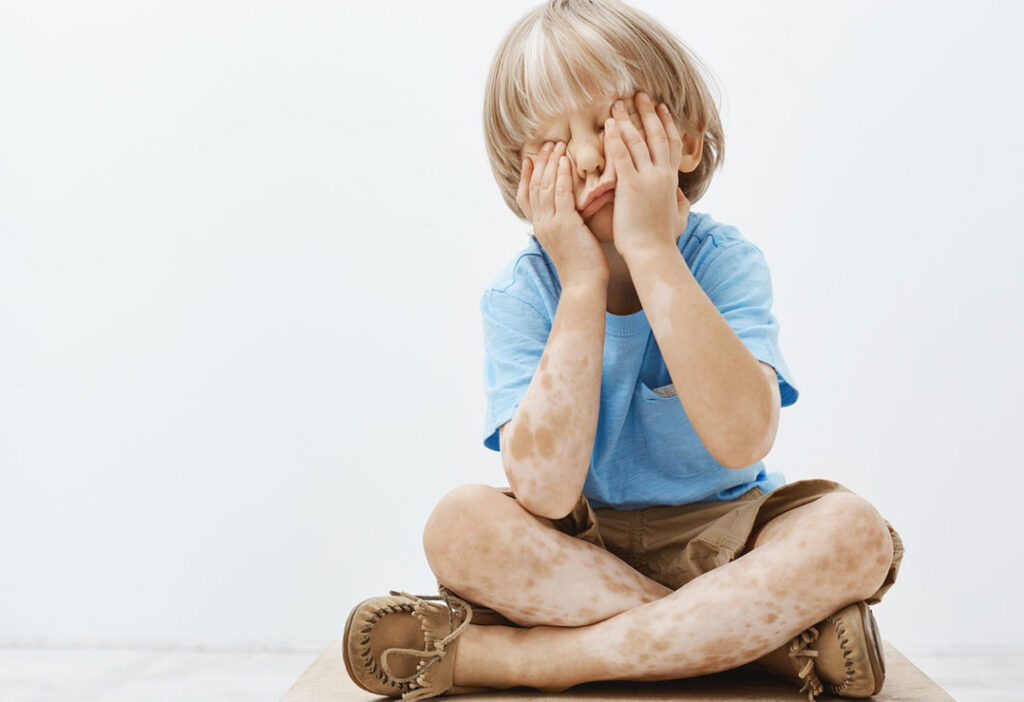Vitiligo

Vitiligo is an autoimmune disease, which affects approximately 1% of the population, where the immune cells start to destroy the melanocyte cells (the cells in our skin responsible for producing pigments) due to a misdirected response. The pigment that gives our skin its normal colour is called melanin, which is made by the melanocyte cells.
In vitiligo, the body creates antibodies to its own melanocytes, and in doing so, destroys them. As a result, the skin cannot make melanin properly,
and this is what vitiligo is. Vitiligo is not contagious, nor life threatening, but can be life-altering as a person with it may have lower self-esteem and could fall into depression.
Typically, vitiligo affects the skin, but it can actually affect anywhere where there is pigment. Patches of hair can turn white and some people may lose colour inside their mouths. In some situations, an eye can lose its colour. The patches are not sore or itchy.
The severity and course of vitiligo is unique to each person. For some, it may only be a few small patches which have developed slowly and have progressed no further. However, for others it may be that the patches develop quickly and then remain unchanged for months, sometimes years. It is common to see the white patches to gradually become bigger and the number of patches around the body to increase. Eventually, large areas of the skin can be affected. Unfortunately, there is no way to predict how much of the skin will be affected once the first patch develops. The white patches can be permanent, but sometimes there is a small chance where patches may regain their colour and return to normal (re-pigment).
For people with vitiligo, it is crucial that they are careful with their skin. They need to make sure that they avoid injuring their skin, as this could result in more white patches being developed in areas of injury. White patches caused by vitiligo cannot tan; they can only burn. Therefore, avoid being in the sun in the hottest times of the day to avoid sunburn. Cover white patches with clothes or a hat where possible, or with high-factor sunblock.
Who gets Vitiligo?
Millions of people worldwide have vitiligo. Nearly half get it before they reach 21 years of age, and most will have vitiligo for the rest of their lives.
Vitiligo occurs equally in people of all skin colours, genders and races.
Symptoms of Vitiligo
White patches on the skin are the main sign of vitiligo. These patches are more common in areas where the skin is exposed to the sun. The patches may be on the hands, feet, arms, face, and lips. Other common areas for white patches are:
- Around the mouth
- Eyes
- Nostrils
- Navel
- Rectal areas
- Genitals
- The armpits and groin (where the leg meets the body)
People with vitiligo often have hair that turns grey early.

There are two main types of Vitiligo
Non-Segmental Vitiligo, Segmental Vitiligo In rare cases, it’s possible for vitiligo to affect your whole body.
This is known as universal or complete vitiligo.
Non-Segmental Vitiligo
In non-segmental vitiligo (also called bilateral or generalised vitiligo), the symptoms often appear on both sides of your body as symmetrical white patches. Symmetrical patches can appear on the:
- backs of your hands
- arms
- skin around body
- openings, such as the eyes
- knees
- elbows
- feet
Non-segmental vitiligo is the most common type of vitiligo, affecting around nine out of 10 people with the condition.
Segmental Vitiligo
In segmental vitiligo (also known as unilateral or localised vitiligo), the white patches only affect one area of your body.
Segmental vitiligo is less common than non-segmental vitiligo, although it’s more common in children. It usually starts earlier and affects three in 10 children with vitiligo.
How We Treat Vitiligo?
We like to treat vitiligo from inside out. We use a combination of homeopathy, lifestyle changes and supplements to reverse vitiligo and get the skin back to great condition.
